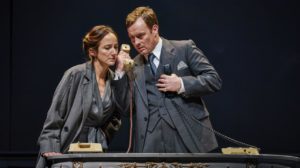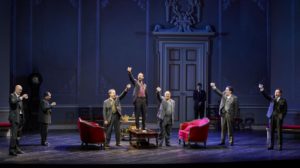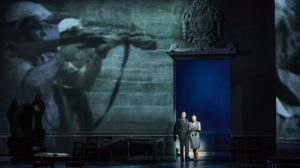
Following an impulse to escape the façade of filmic structure and actually learn something from “the craft” I ended up at the Harold Pinter Theatre in the most diverse auditorium I have ever experienced; culturally and demographically.
Very rarely do I attend a piece of theatre without an agenda to dislike it due to disproportionately high-ticket prices, however, tonight every penny and pound was well worth investing; Bartlett Sher’s production, for the National Theatre, was a lesson well taught on a difficult, sensitive and currently extremely relevant challenge; conflict. Sher’s direction utilised Brecht’s concept of the Verfremdungseffekt to scrutinise our judging behaviours towards what we all unintentionally practise as prejudice.

The face value of Rogers’ play concerning a peace deal between the Israeli and Palestinian governments is projected by Sher to have a much more powerful incentive than to educate the packed auditorium; but rather to reflect the severity of current conflicts that are erupting not only concerning Eastern Europe but all over the world and ever more recently our own door step.

Through the use of projected media images and live records we were transported from a piece of powerful political performance to the reality of the collateral damage on the streets of Gaza. The impact was further amplified as Mona, one of the Norwegian politicians, shares with us the impact it had on her as she “saw it. Two boys facing each other, one in uniform, one in jeans, weapons in hand, hate flowing between them. But their faces—and we both see this—their faces are exactly the same. The same fear. The same desperate desire to be anywhere but here.”[1)
The design of both the performance space and the play supplemented one another clearly to aid the storytelling. Despite not being a “well-made play” and transforming the Classical or Aristotelian unities; the majority of the story was shared in the same design of board room with minor differences to clearly define its different global locations; when a new location was introduced It would be so verbally by the Norwegian politicians whose story it was that was being told. This technique of storytelling in a single shared space via breaking the fourth wall encouraged me to believe in the storytelling even more, as I was seeing the events from the perspective of history, whilst hearing the events from the recollections of the Norwegian politicians who experienced it.
Regardless of being a contemporary spectacle at times, the play still adhered to a classical structure accurately climaxing in moments of extreme tension which was cleverly juxtaposed with moments of estrangement juggling with my hope – to ideally end in a resolution which would leave me feeling proud to be a part of the human race – however, this was not the case. Here is where the story telling became more important than whether the play was “a good one” according to the structural critics; the resolution was promised and upheld and peace was planned, however Sher once again brought us back to the reality of the current conflict reminding us this is not just a play.
(1) Oslo by J.T Rogers. TGC publication
Get The Chance has a firm but friendly comments policy.
